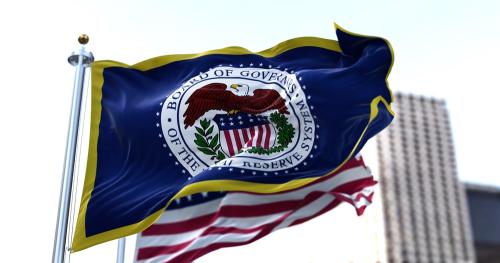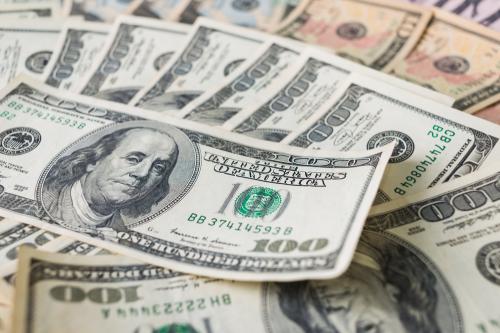European Monetary Union—also known as the euro-zone and euroland—came into existence on January 1 among eleven countries of the European Union with a new currency—the euro—and a new European Central Bank. Having the same currency, the eleven countries are likely to enlarge their mutual trade. The euro’s exchange rate will float in terms of the dollar and the yen. Some neighboring countries will adopt the euro as their reserve currency but it is likely to become a worldwide reserve currency, competing with the dollar, only gradually. The same is true of the euro’s function as an international asset and means of payment for the private sector. The United States has every reason to welcome this further step in European economic and financial integration.
POLICY BRIEF #42
Economic and Monetary Union (EMU) in Europe will come into effect on January 1, 1999, among 11 countries of the European Union (EU). The single currency—the euro—will enter into use, and the European System of Central Banks (ESCB) will establish a common monetary policy for what has come to be called euroland.
This will be a historic event. For the first time since the Roman Empire, a good part of Europe will have the same currency. The euro will also have the unusual quality of not being issued by a sovereign government.
During a three-year transition period, the 11 currencies will coexist with the euro, but their exchange rates will be irrevocably locked together. Business firms can, if they wish, switch immediately to the euro. Many financial instruments, including government securities, will be redenominated into euros immediately in January 1999. After June 30, 2002, the euro will be the sole currency in the region.
Four member countries of the European Union—Denmark, Greece, Sweden, and the United Kingdom—will not be initial members of EMU but could join later. They are referred to as pre-ins. It has been agreed that their exchange rates will be linked to the euro in an arrangement similar to the European Monetary System, with its Exchange Rate Mechanism, which has functioned since 1979. London, with its highly developed financial markets, will likely be the locus for many euro transactions whether or not Britain joins the EMU.
The ESCB consists of the European Central Bank (ECB) in Frankfurt and the 11 existing national central banks. While the Bundesbank served as the model, the arrangement is somewhat similar to the Federal Reserve System: the ECB, with a six-member Executive Board, is comparable to the Federal Reserve Board in Washington, and the national central banks are the analog of the 12 Federal Reserve Banks. Authority over monetary policy resides in the ESCB Governing Council, consisting of the Executive Board and the 11 presidents of the national central banks. Although there are obvious differences, the Governing Council corresponds to the policymaking Federal Open Market Committee in the United States.
With that background, we turn to the question of the effects of the EMU on the rest of the world.
The Questions
Questions regarding the international effects of the EMU are not difficult to formulate, but some of the answers are problematical.What will be the effects on trade with the rest of the world? Will the exchange rate of the euro appreciate, depreciate, or remain stable in terms of the dollar, the yen, and other currencies? Will the euro become an important reserve currency, challenging the international role of the dollar? Will the euro be widely used internationally by the private sector as a unit of account, a means of payment, and a store of value—the three traditional functions of money? A related question pertains to the potential importance of financial markets in euroland for international flows of capital. Finally, how will euroland, without a finance minister, relate to the United States, Japan, other countries, international financial institutions such as the International Monetary Fund (IMF), and international fora such as the Group of Seven and the newly formed Group of 22?
Effects on Trade
Euroland has a population somewhat larger than that of the United States and a gross domestic product somewhat below the GDP of the United States. Its total merchandise trade with the rest of the world (excluding intra-EMU trade) exceeds that of the United States by a small margin. Thus the two regions are of comparable size economically, but the United States has a much larger geographical area and therefore a much smaller population density.
With the euro in existence, trade among the 11 countries will not require the purchase or sale of foreign exchange. nor will contracts for transactions among the countries be subject to uncertainties regarding future exchange rates. Furthermore, with prices quoted in the same currency (the euro) in all 11 countries, firms in euroland are more likely to trade with one another and consumers are more likely to purchase products made in other euroland countries.
In those circumstances, trade among the 11 countries will probably increase in relation to their trade with the rest of the world. Both imports from and exports to non-EMU countries would increase less rapidly than in the past.
The Euro’s Exchange Rate
Euroland will be a much more closed economy than its pre-EMU members, since their mutual trade will become internal. It follows that policymakers will be less concerned about fluctuations in the foreign exchange value of the euro than officials in the individual countries were about their pre-EMU exchange rates. In other words, the attitude toward the exchange rates of the euro will be more like that of American officials.
The euro will float in relation to the dollar, the yen, and other currencies not pegged to it. The suggestion by Germany’s finance minister Oskar Lafontaine that target zones be adopted has been rejected by other European leaders, including the president of the ECB, Wim Duisenberg.
Whether the euro will tend to appreciate or depreciate in relation to the dollar in the early stages is quite unpredictable. The short-term interest rate that is likely to exist at the ECB in January is 3%, the basic rate in France and Germany toward which other central banks have been reducing their rates in anticipation of the Union. In the United States, the basic short-term rate—the Federal finds rate—was about 4.75% as of mid-December. That alone would point to some appreciation of the dollar in relation to the euro.
On the other hand, the euro area has a surplus in the current account of its balance of payments (estimated at more than US$100 billion in 1998), while the United States has a growing deficit (estimated at well over US$200 billion in 1998). Apart from other influences, that would tend to lead to some depreciation of the dollar. But there are other influences: the growing current-account deficit of the United States has not depressed the dollar in the past year, given the high mobility of private capital that easily financed the deficit.
It is fairly safe to predict that the dollar-euro exchange rate will not move by a large amount in early 1999 unless, as is discussed below, large shifts occur in the dollar balances of official and private holders around the world. The yen could move in relation to both the euro and the dollar, as it has in the past year.
The Euro as a Reserve Currency?
The dollar has for many years been the dominant reserve currency, the currency in which countries around the world hold their foreign exchange reserves. At the end of 1997, 57% of official foreign exchange reserves worldwide were held in dollars. The deutsche mark accounted for 12.8% and the French franc for 1.2%, while the yen accounted for 4.9 percent of foreign exchange reserves.
Are countries likely to shift their official reserves out of dollars into euros? Those countries that link their exchange rates to European currencies—by a currency board, a fixed or crawling peg, or a managed float—probably already hold deutsche marks or other European currencies in their reserves. That applies mainly to countries in Eastern Europe, most of which link their currencies to the deutsche mark since much of their trade is with Germany. They will very likely hold their reserves mainly in euros.
How rapidly, if at all, will other countries switch their reserves to the euro? Of those that peg their exchange rates, most do so to the dollar or to a basket of currencies in which the dollar is dominant. They are unlikely to switch on a large scale. Furthermore, most Latin American and Asian countries have closer trade relations with the United States than with Europe. They are likely to stick to the dollar, but they could gradually diversify their reserve holdings. What can be said with some assurance is that if switches of reserves from dollars to euros do occur, the process will be gradual. Central banks around the world would certainly avoid large sales of dollars and purchases of euros, since that would tend to lower the value of their remaining dollar holdings.
Is the euro likely to be acquired by countries with growing reserves? It is worth noting that a currency can take on an increasing role as a reserve currency only if its issuer incurs an overall balance of payments deficit. In other words, if holdings of a reserve currency are to increase, there must be a supply as well as a demand for it. The United States has demonstrated that principle over the years either by running a current-account deficit, as in recent times, or by having an excess of capital outflows over its current-account surplus, as in the 1950s and 1960s. At present, euroland has a sizable current-account surplus. The question is, will it become a substantial exporter of capital?
Another condition for reserve currency status is the existence of financial markets in which monetary authorities are willing to invest their foreign exchange reserves. As noted below, that is also important for private holdings of a currency outside the borders of the country that issues it.
Does It Matter?
In the 1960s, Charles de Gaulle, president of the French Republic, characterized the reserve currency role of the dollar as an “exorbitant privilege” for the United States. In that period, current-account deficits and surpluses were financed to a much larger degree than at present by movements of official reserves. In particular, when France had a current-account deficit, it had to use its scarce reserves of gold and foreign exchange to finance it. On the other hand, when the United States incurred a balance of payments deficit, it simply paid out dollars, most of which were added to the reserves of other countries.
Today, payments imbalances—especially of major industrial countries—are more easily financed by flows of private capital.
To what extent is reserve currency status important to the United States? It is significant that the United States pays interest on the dollar assets of foreign monetary authorities that are held in the form of bank deposits or securities. That means that financing a deficit by an increase in liabilities to official holders of dollars is not very different from explicit borrowing in the form of security issues. The main advantage is that American medium- to long-term interest rates are probably somewhat lower than they would be if the dollar were not a reserve currency. But that difference has to be rather small.
The major financial benefit the United States derives from the distinctive international status of its currency is seignorage: the accumulation of paper dollar currency abroad, since no interest is paid on such holdings. It is estimated that such dollar holdings in other countries amounted to between US$200 billion and US$250 billion at the end of 1995. With medium-term interest rates at, say, 5%, that represents an annual saving of US$10billion to US$12.5 billion, or a little more than one-tenth of 1% of America’s gross domestic product.
The Euro in Private External Balances?
Private holdings of international assets are of much larger size than official balances. For the world as a whole, the private portfolio amounted to about $7.5 trillion in 1995. Of that total, a bit more than half was denominated in dollars, twice the amount held in the currencies of all 15 EU countries (when intra-EU holdings are deducted).
How important will the euro be internationally as a private unit of account, means of payment, and store of value? According to data collected by the Bank for International Settlements, the dollar is involved in more than 80% of all foreign exchange transactions. Almost half of world trade is priced in dollars. That provides an incentive for corporations engaged in international trade to maintain working balances in dollars. But the existence of a single currency for much of Europe is likely to lead to a gradual increase in the extent to which Europe’s trade with other countries is denominated in euros. That in turn would induce traders abroad to hold euro balances. But such balances are a small fraction of private international holdings of foreign currencies. Cross-border investment and lending are of major importance.
That is where the difference in financial structure between Europe and the United States becomes relevant. Although total financial assets are of about the same magnitude in euroland and in the United States, bank assets make up well over half of the total in Europe but less than half in the United States. In other words, securities markets are much more developed in the United States, whereas banking is more prominent in Europe. It is true that the amount of government bonds outstanding in the 11 euroland countries is about equal to U.S. Treasury bonds outstanding. But only one-fourth of corporate finance in continental Europe comes from capital markets. In the United States, the figure is about three-fourths.
The advent of the euro could lead to the enlargement of securities markets in euroland. The stock exchanges of Frankfurt, London, and Paris, and probably others, are planning to create a unified trading system for equities. If the single currency encourages the development of deeper and more active markets for other securities of various maturities—ranging from commercial paper to bonds—that will in turn tend to attract more funds from abroad. But those developments would also attract more borrowers from abroad. Thus one cannot predict whether greater securitization in euroland will tend to strengthen or weaken the foreign exchange value of the euro.
In any event, this evolution toward greater securitization in euroland will not happen overnight. According to the Economist (November 21, 1998, p. 72), progress toward a “single, homogeneous capital market” is likely to be “grindingly slow” since it depends in part on a harmonization of taxes, regulation, supervision, listing requirements, accounting, and trading rules. EMU and International Cooperation
The member states of the EMU will continue to be members of the International Monetary Fund. Even though they will have given up their exchange rates and balance of payments policies, they will retain their sovereignty, including fiscal policy and other domestic policies. Thus the IMF will continue to conduct consultations with the member governments, as it does with Luxembourg, which, as part of the Belgium-Luxembourg Economic Union, does not have a separate exchange rate or balance of payments. But when it comes to monetary policy, the IMF will have to consult with the ECB. On exchange rates, the relations with the IMF will be more complicated. According to the Maastricht Treaty, it is the EU Council of Ministers that has authority over the “general orientations” of exchange rate policy. But the ministers “have agreed only to issue so-called orientations for exchange rate policy in exceptional circumstances such as a clear misalignment of the euro which is likely to persist.” Thus it is the ECB that will be concerned with the exchange rate on a day-to-day basis.
Representation in other fora such as the OECD, Group of Seven, Group of Ten, and similar councils will also be complicated. When finance ministers and central bank governors meet, presumably there will be only one central bank governor from euroland, the president of the ECB. Finance ministry representation remains to be determined; the EU has proposed that, at Group of Seven meetings, the EMU be represented not only by its permanent members (France, Germany, and Italy) but also by the rotating president of the ministerial council along with a representative of the European Commission in a subordinate role “to provide assistance.”
The general question that is raised by this diffusion of authority has been expressed as follows: Whom does the U.S. secretary of the treasury call on the telephone when a foreign exchange crisis arises? The current unsatisfactory answer to the question seems to be that the treasury secretary would call three people in Europe: the current president of the Council of Ministers, a representative of the European Commission, and the ECB. A similar question would arise if and when it becomes desirable to coordinate economic policies among groups of countries, as has occurred from time to time among the Group of Seven nations.
It is reasonable to assume that these problems will be ironed out over time. Meanwhile, there is no reason why the United States should not welcome the establishment of the EMU and the creation of the euro.


